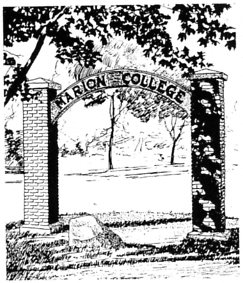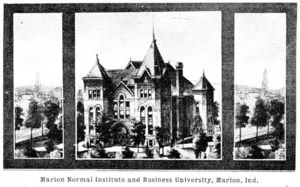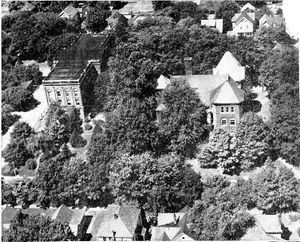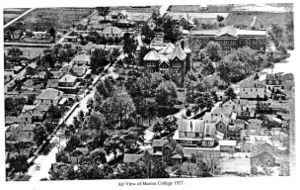Marion College
Contents
Marion College 1880-1918
In 1880, Marion Normal College was begun by Thomas Diggs Tharp and though this was the first college, formal education had existed in Marion before this (Elder 7; “College Opened Here in 1858”)(“College Opened”). Tharp had been in the ministry of the Methodist Episcopal Church, in which the Wesleyan Church has its roots (Elder 7). “That first spring normal in 1880 reportedly had ‘a splendid student body,’ but the exact number is not known.” (“College Opened”). Tharp later “disposed of the school” to Dr. Joseph Tingley, who opened a normal school in 1885 (Elder 7-8; “College Opened”). Tingley’s successors moved the school to “College Corner,” 38th and Washington Streets (Elder 8). Professor A. Jones, from Danville, Indiana, was a founder “whose contribution can hardly be overestimated.” (Elder 8). The college, with Jones as the president, enlarged in 1894 to what was named the “Old Triangle” (Elder 12). This “Old Triangle’ contained the Ad Building, which is still in use on the campus of Indiana Wesleyan as the oldest building on the campus (“John Wesley Administration Building”). The College steadily grew in size, but in 1912 it was sold and moved to Muncie (Elder 22)(“College Opened”). As the interest for higher education remained in Marion, Marion Normal Institute was opened in September 1912 with Lawrence V. Jackson as president (“College Opened”). However, the hardships of World War I caused this institute to last only six years, closing in 1918 (“College Opened”; Elder 55). The city of Marion remained interested in higher education and the Wesleyans, who had located a Bible college in Fairmount for fourteen years, were looking to relocate (“College Opened”). These two would come together in 1920. It was the city of Marion that played a huge role in keeping the doors of the normal opened.The City of Marion took great pride in her Normal school, and rightly so. They praised her when she succeeded, lauded her successful leader, hung on as the Gas Boom waned, came to the rescue when the Normal College moved to Muncie, fostered a Marion Normal Institute until World War I and other factors forced the school to close in 1918, received with great delight that the Wesleyans might establish a college in the City of Marion, worked to secure the Wesleyan college for their city, and welcomed Dr. Bedford, his staff, and the students with receptions, praise, and continuing support (Elder 9).
Marion College 1920
The first year of the new Marion College, begun in 1920, was a year of transition for the college but also proved that the city of Marion believed in higher education, and that the professors and students of the college believed in its mission. Before 1920, the local education for the Wesleyan Methodist Church was the Fairmount Bible School (Goodman). The Administration Building and Teter Hall (see Appendix B and Appendix C) standing empty, Marion was searching for a buyer in order to continue having a college in the city (“Celebrating 75 years of excellence”). “It was not long before city leaders learned that the Wesleyan Church was planning a college in Indiana.... In the summer of 1919, the city sold the property to the Wesleyan Church. Marion College began serving students in 1920.” (“Celebrating”). Professor A. Jones remained from the former Marion Normal College, and would remain with this new institution until his death at age 78 in 1933 (Elder 137). The first president of Marion college was Dr. H. C. Bedford (Dodd 2; Elder 62). As Mary C. Dodd, a senior the first year and later a faculty member, wrote in her Marion College: A Brief History, it was really a year of firsts(Elder 82).The first president, Dr. H. C. Bedford gave tirelessly in the early period of organization.... The first faculty, then as since, was composed of individuals of various degrees of scholarship, various capabilities, various temperaments.... The first student body on October 9, 1920 numbered 252; of this number 42 were enrolled in the college department; 3 Seniors, 1 Junior, 6 Sophomores, 32 Freshmen (Dodd 2).
The people of Marion looked positively upon the new college (“The City Speaks Out”). “We have said it before and we repeat it now, nothing has ever come to Marion of as much importance as the new Wesleyan College. . . . We can truthfully say in a sense that this institution is worth more to Marion than all the manufacturing plants it has or possibly might have.” (“The City Speaks Out”). The hard work Marion put into attaining a new college and the great aspirations of the college faculty set the new Marion College up for a bright future.
Marion College after 1920
“‘Oh God, we pray, give us schools where the Youth may be educated in Knowledge and GODLINESS, that the commonwealth be furnished with knowing and understanding men and the church with an able ministry.’ Such was the heart cry of President John W. Leedy in 1923. (“First Things First”). The aims of Marion College as a Wesleyan college would be slightly different than those of the Normal, however, its promise of education was what Marion had been hoping for. In “Celebrating 75 years of excellence,” the author writes that the college was originally known for its teacher education and ministerial studies programs, but the college would expand its programs in later years to many majors. In the years that followed the first year of Marion College, the city continued to have positive regard for the institution. In 1933, it was written in the Marionette, “We, the members of the “South Marion Business Mens’ Club Inc.” appreciate Marion College because of the high ideals and morals that are upheld there, realizing that many colleges and universities are majoring only in the mental and physical factors of youth.” Marion College went through difficult times, monetarily during the depression and administratively when President Bedford resigned, and later when the second president, President Leedy, had trouble with the Board of Trustees (Elder 105, 93, 104). However, the aim of Marion College remained the same—to educate—and the college played a large role in the city of Marion. As Elder writes, “But the Lord had not yet accomplished His work through this college that He had helped His people to found.” (105).Conclusion
Marion Normal College and Marion College, growing from the “Old Triangle” and also from the dedication of many, many people, remain a huge part of Marion to this day in the form of Indiana Wesleyan University. Beginning as early as 1858 and extending to 2007, and beyond today, the college present in Marion demonstrates a desire in the city for college education and the school that helped make that desire real and even more important.
Works Cited
- "Celebrating 75 Years of Excellence." Chronicle Tribune 16 July 1995.
- Cole, M. S. "Alma Mater Changes." Marion College Bulletin Alumni Issue.
- "College Opened Here in 1858."
- Elder, Marjorie J. The Lord, the Landmarks, the Life: Indiana Wesleyan University. Marion: Indiana Wesleyan University, 1994.
- "First Things First." Marion College Bulletin Alumni Issue.
- Goodman, Woodrow. Bridge Over the Valley: Memoirs of Woodrow Goodman.
- "John Wesley Administration Building." Indiana Wesleyan University. 2007. 23 May 2007 <http://cas.indwes.edu/Student%2DLife/Campus%2DTour/john-wesley-admin.asp>.
- “Marion College.”
- "Marion Normal College Dormitory." Map. Sanborn Map 19601 Plate 19.
- "Marion Normal College." Map. Sanborn Map 1896 Plate 19.
- "Marion Normal College." Map. Sanborn Map 1901 Plate 16.
- Marion Normal College School of Science Building. Marion.
- Markwith, Pat. "The "Old Triangle" Reveals History of Interesting Events." The Journal 19 Oct. 1961.
- Mary, Dodd C. Marion College: a Brief History. Marion: Marion College, 1945.
- "Reminiscing."
- "The City Speaks Out." Marion College Bulletin Alumni Issue.
- "Triangle Tales." Marion College Bulletin Alumni Issue.
Credits
This article was written by Elizabeth King and submitted on June 5, 2007 for Mr. Munn's AP US History class at Marion High School.



